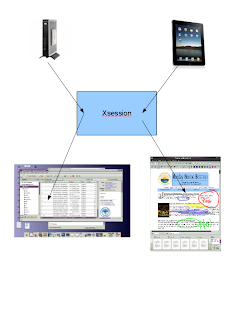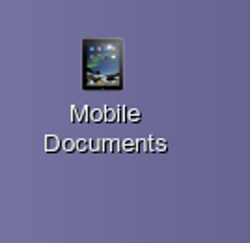Sometimes it's very hard to pack many months of conversations and needs analysis into blogs. My current project is just such an issue; I could type paragraphs describing the specifications but will try and be concise. We have tried to close up a number of open requests with one design.
There is a growing demand for mobile solutions that allow users to move around the building and gain access to their files. Our centralized design makes this easier, and many different concepts were discussed. The first inclination is to move in the direction of getting a laptop footprint device. Those of you that have seen my previous posts know that we already have a mobile laptop thin client that is being tested. The laptop footprint is not the best for meetings. Sitting in a room with 10 screens flipped up is not really ideal, and then you have to consider power needs, cords and batteries. They also are not suited for what people want to do most: annotate over the top of previously created documents. It would be wonderful if regular users worked as we do in the computer field with Wikis and sharing information, but that's not how they work at this time. They still want to annotate over the top of document with their own notes. Currently this is being done pen to paper. Technology changes are sometimes done in baby steps.
So if your IT department is like ours, you are not as staffed as you would like and the hours of the day are filled. So how do you add a new type of technology and still maintain a quality design? Replacing the thin clients at the users desktops with something they can pick up doesn't make sense. Our desktop cost is 600 dollars (400 thin client + 200 monitor) with a projected 10 year duty cycle. Annual costs are minimal. Laptop footprint devices (even thin client laptops) would then have lots of docking and undocking, snapping of wires, cords being moved, monitors plugged in, USB devices plugging and unplugging...all very expensive to support and problematic. Why change one of the most stable parts of your network? It was clear that our efficiency and cost savings should then be obtained from our printing infrastructure. We don't have desktop printers which are very expensive to maintain, but instead run departmental laser printers. Our printing costs and printed page counts are still too high in my view. There are people that print pages during document construction and then hand write notes on the pages; and some people print email messages in order to read them. Nearly every meeting involves pages being printed and handed out to employees. There has got to be better ways of working, and this for sure is the area that needs attention.
So what I am developing now with the IT Director is a way to integrate an iPad footprint device into our design as a way to reduce printing costs. The goal is to give them the power of the devices, but not allow them to store documents locally.
In prototype form I have accomplished the design below. I'm simulating this work flow on a thin client until NX 4.0 is relased.
NX/Nomachine 4 will allow you to log into our servers with Safari directly from an iPad. The server will then detect your Xserver is 768x1024 and know that you are on a tablet and then bypass starting GNOME in favor of a UI designed just for this footprint. This will allow you to be logged into the server with a full GNOME desktop and also a tablet device at the same time. The UI opens in a split second, and will offer much faster response time than waiting for a desktop to start. The image below shows Xsession passing you to the two environments based on Xserver size criteria.

The workflow that we have worked out so far is: When users log into GNOME they always have the following icon on their desktop. This opens a Nautilus folder into which they can drop and drag PDF and OpenDocument files. Anything in this folder is staged then for the iPad devices.

The shot below shows the current UI that is displayed in the 768x1024 footprint, exactly what will be seen on iPads. The panel at the bottom appears and thumbnails are generated of everything in $HOME/MobileDocuments sorted in reverse order newest to oldest. Clicking once on the document will display information about the document on the status line. Pressing Open will open it in either Xournal or OpenOffice. Xournal will allow them to use a stylus pen and mark up the meeting notes in their own handwriting. These documents are always on the server, and when they return to their desks they are available for immediate reference and further editing.
The iPad also has Dragon Naturally Speaking, and I have created a small multi-line text widget that will accept a paste from the local device. Once pasted, the button "Save Dragon Document" will become active. When they click this button, the text will be converted into OpenDocument (with perl modules) and a unique date stamped file name auto generated. The document will then display on the left of the panel as a thumbnail and be available for editing.

To answer the questions that I think will be coming :) -- ** Yes other tablets will be reviewed and the market is always monitored. This design is elegant in that it does not lock you into a certain vendor. ** Yes the UI is very basic and will evolve and probably sux. I'm more focused right now on this work flow. ** Yes iPads are $500 a piece, but even buying 10-20 of these would be but a small dent in our printing budget. A 10-20% reduction in printing might pay for the hardware in the first year.
I'm looking forward to testing this workflow and it's proceeding as a back burner project along with my primary projects.








